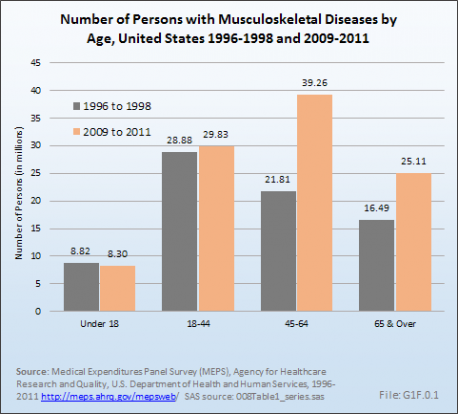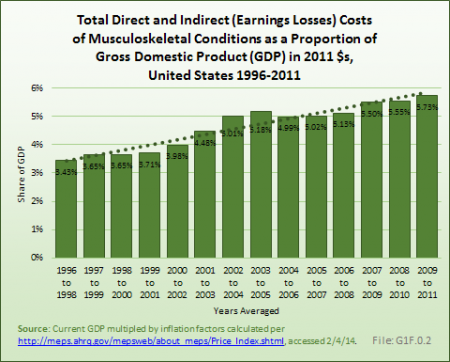



The increasing prevalence of musculoskeletal conditions, along with a growing and aging population, has resulted in more than a 50% increase in total aggregate direct cost to treat persons with a musculoskeletal condition over the past decade, in constant 2011 dollars. For the years between 2009 and 2011, the annual average direct cost in 2011 dollars for musculoskeletal health care—both as a direct result of a musculoskeletal disease and for patients with a musculoskeletal disease in addition to other health issues—is estimated to be $796.3 billion, the equivalent of 5.2% of the national gross domestic product (GDP).
Total medical care costs are the costs for all of an individual’s conditions, including musculoskeletal conditions. Incremental medical care costs are that part of total medical care costs attributable solely to the musculoskeletal conditions. Incremental medical costs for musculoskeletal conditions for the years between 2009 and 2011 are estimated to be $212.7 billion, in 2011 dollars. (Reference Table 10.6 PDF [9] CSV [10], and Table 10.14 PDF [7] CSV [8])
Indirect costs measure disease impact in terms of lost wages due to disability or death. Indirect costs, like medical care costs, can be estimated and calculated in total for all the medical conditions an individual has, and as the increment attributable solely to musculoskeletal conditions.
Indirect cost for persons age 18 to 64 with a work history add another $77.5 billion, or 0.5% of the GDP in between 2009 and 2011, to the cost for all persons with a musculoskeletal disease, either treated as a primary condition or in addition to another condition. Annual indirect costs attributable to musculoskeletal disease alone (incremental cost) account for an estimated $130.7 billion. Indirect costs attributable to musculoskeletal disease are greater than total indirect costs because of a 4% gap in the probability of working between persons with and without a musculoskeletal condition and a lower mean income. (Reference Table 10.12 PDF [11] CSV [12])
Links:
[1] https://bmus.latticegroup.com/docs/T10001.1.pdf
[2] https://bmus.latticegroup.com/docs/T10001.1.csv
[3] https://bmus.latticegroup.com/docs/T10002.1.1.pdf
[4] https://bmus.latticegroup.com/docs/T10002.1.1.csv
[5] https://bmus.latticegroup.com/docs/T10011.10.pdf
[6] https://bmus.latticegroup.com/docs/T10011.10.csv
[7] https://bmus.latticegroup.com/docs/T10015.14.pdf
[8] https://bmus.latticegroup.com/docs/T10015.14.csv
[9] https://bmus.latticegroup.com/docs/T10007.6.pdf
[10] https://bmus.latticegroup.com/docs/T10007.6.csv
[11] https://bmus.latticegroup.com/docs/T10013.12.pdf
[12] https://bmus.latticegroup.com/docs/T10013.12.csv